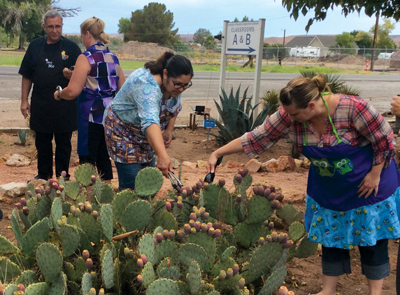By BALEIGH BOND
Moapa Valley Progress

A free workshop was held at the University of Nevada Cooperative Extension on Wednesday, July 19 at 9:00 AM. Around a dozen individuals from Moapa Valley, Mesquite, and Las Vegas, who had signed up online prior to attending the event, congregated in a classroom at the Cooperative Extension facility. From class leader Cally Wade, the group was taught how to harvest prickly pears straight from the cactus and then to use the fruits to make and jar jelly.
Within the arid ecosystem of the driest desert in North America, the Mojave Desert, thousands of different species of flora and fauna live and thrive. One of those species is the Opuntia cactus, also known as a prickly pear. The prickly pear cactus is just one of many varieties of cacti in Southern Nevada.
The hard-skinned fruits, varying in color and covered in spines, can be found sitting atop the sharp paddles (also called nopales) of a prickly pear cactus. These fruits can be used in things like jams and jellies and for many other culinary applications. Once it is jarred, prickly pear jelly can typically last for 18 months to two years.
Participants in the workshop were given the opportunity to pick the pears themselves. Three methods of harvesting were shown as examples. One way that was exhibited was using tongs to twist and pull the pears off of the cactus pads, depositing them into a gallon bucket, and pressure washing the spines off with an everyday garden hose.
Safety guidelines were laid out as the techniques were demonstrated. The guidelines aided in the process and ensured that the larger spines and the smaller hair-like glochids attached to the rough skin of the fruit stayed far from the fruit pickers’ hands. During the fruit picking session, every hand made it through and came out unscathed at the conclusion.
After the harvesting was concluded, the fruits were taken into the classroom, sliced, and placed into steam juicers. Here the juice was extracted so that it could be used to make the jelly. The fresh juice and other various ingredients were combined according to a recipe. The jelly was then put into jars for storage. As the jelly was being made, storage guidelines and types of equipment that could be used in the jelly making process were discussed. The participants were able to glean an incredible amount of jelly making knowledge from masters of the art for use in their own homes.
Information about other workshops and seminars offered by the Extension can be found online at coopextensionnortheastclarkcounty.wordpress.com/.










